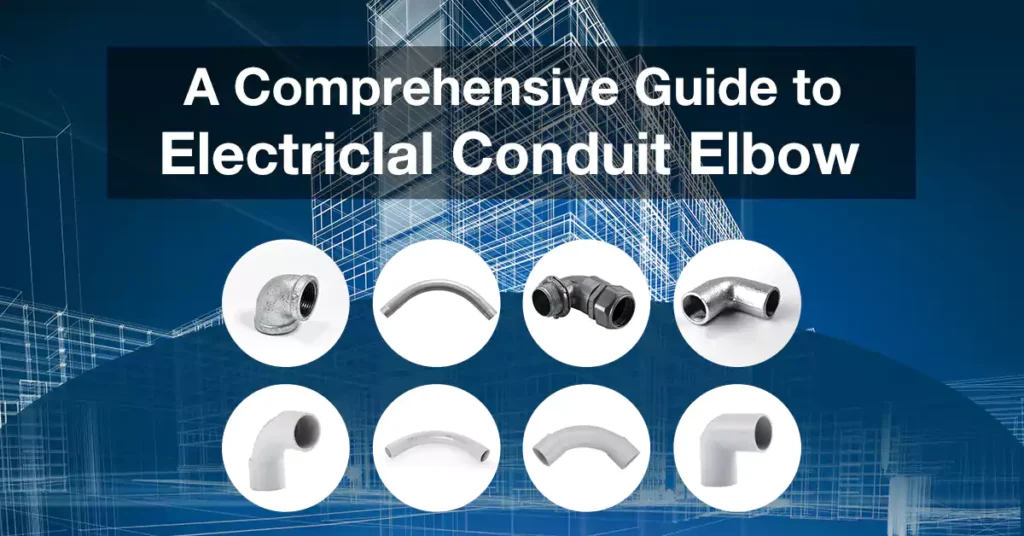
目录
When dealing with electrical installations, the conduit system plays a vital role as a crucial component. This system, which consists of conduits and fittings, serves the purpose of safeguarding and organizing electrical wiring. By doing so, it prevents potential hazards and ensures a seamless flow of power. Among the numerous fittings available, one particular type, known as conduit elbows, holds significant importance in any electrical installation project. In this comprehensive guide, we will explore all the essential aspects of conduit elbows to help you have a better understanding of this conduit fitting.
What is Electrical Conduit Elbow?
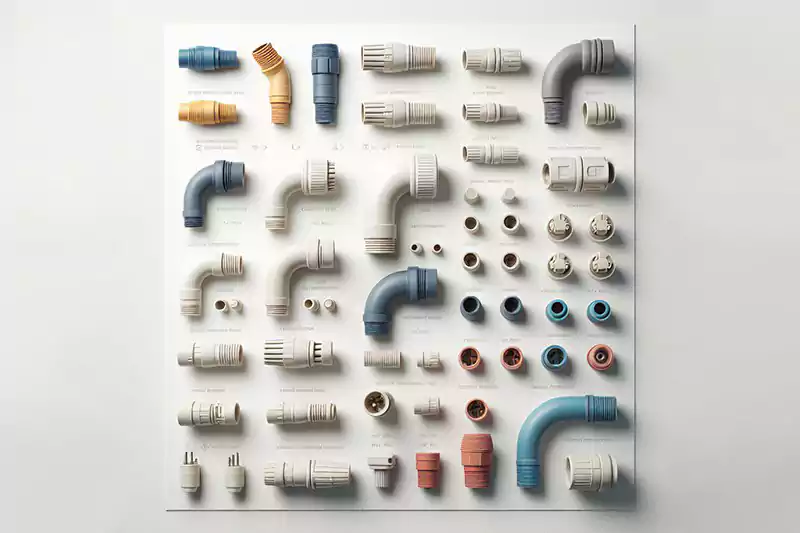
An electrical conduit elbow is a type of fitting used in electrical installations to change the direction of a conduit system. It is designed to connect two sections of conduit at an angle, allowing the wiring to navigate corners, bends, or changes in direction. Conduit elbows are typically made of metal or non-metallic materials and are available in various sizes to accommodate different conduit diameters.
These elbows are essential for routing electrical wiring in a safe and organized manner. They ensure that the wiring is protected from damage and provide a neat and professional appearance to the installation. By allowing the conduit system to navigate obstacles and change direction smoothly, conduit elbows help maintain the integrity of the electrical wiring and prevent potential hazards such as wire strain, sharp bends, or accidental damage.
Electrical Conduit Elbow Types
There are many types of electrical conduit elbows, each designed for specific applications, and the elbows used in different countries could be little different, here are some common used types.
90 Degree Elbows: This elbow type is widely used in situation where a sharp direction is required within an electrical conduit system. They provide a precise right angle of 90 degrees, enabling the conduit to navigate corners and changes in direction with optimal efficiency.
45 Degree Elbows: This type is usually used when a more gradual turn needed, instead of a rigid angle, angling the conduit at 45 degrees.
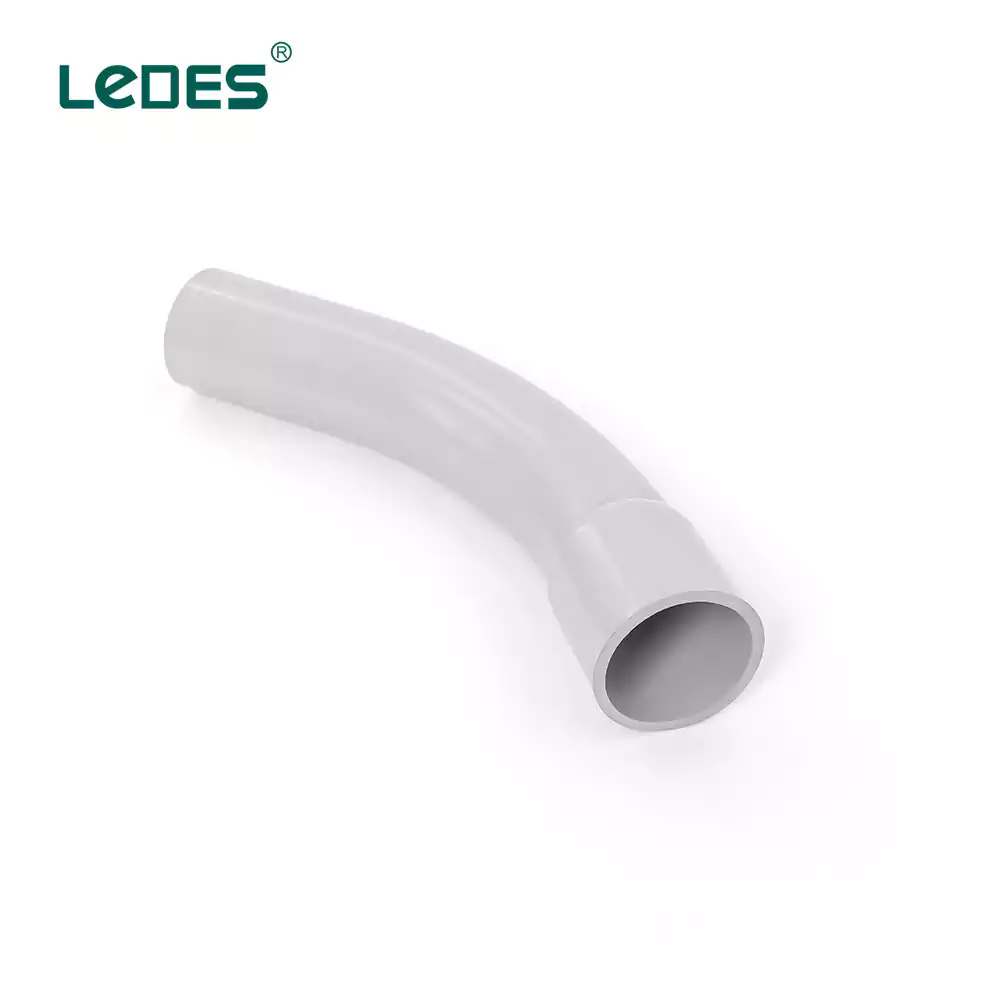
30 Degree Elbows: This type of elbow creates a moderate turn of 30 degrees, providing a more gradual change in direction compared to sharper angles like 45 or 90 degrees.
22.5 Degree Elbow: 22.5-degree elbows are primarily used when a conduit system needs to make a slight bend or navigate a specific angle that is not as sharp as a 45-degree or 30-degree turn.
UL and CSA Standard Elbow Types
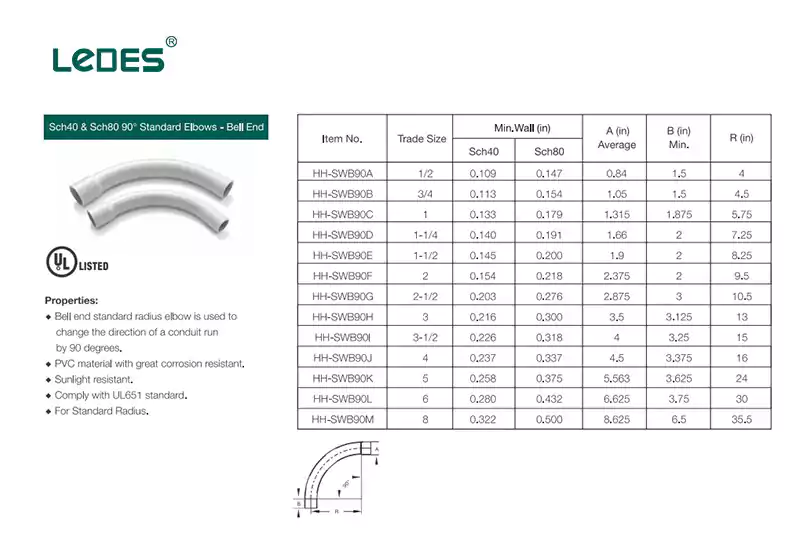
In America and Canada, they do widely use these types of elbows to help to make different angles turn in the conduit system, but the dimensions and some of the performance requirements are slightly different compare to the America UL and Canada CSA standard elbows.
Here are the dimensions for UL and CSA standards.
Australia AS/NZS Standard Elbow Types
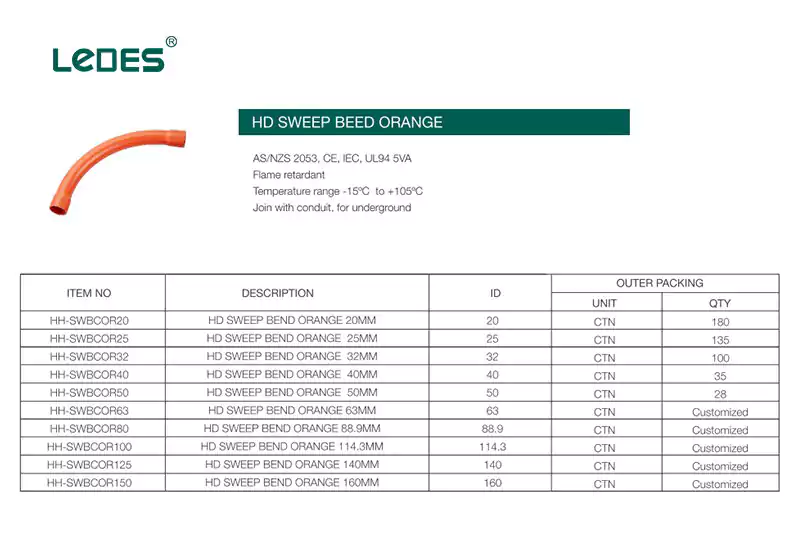
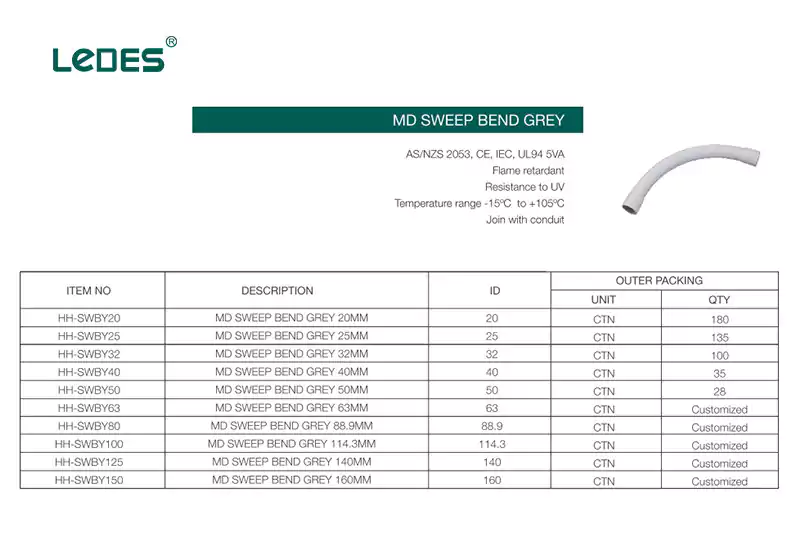
In Australia, the elbows and bends could be different, they do have different angles like 90 degrees, but there are many different types, include:
Heavy Duty Sweep Bends: A heavy-duty sweep bend is a robust conduit fitting designed to handle demanding applications where durability and strength are paramount. These bends are engineered to withstand heavy loads, extreme temperatures, and harsh environmental conditions while providing smooth changes in direction for electrical conduit systems.
Medium-Duty Sweep Bend: A medium-duty sweep bend provides a balance between strength and flexibility in conduit systems. These bends offer a moderate radius, making them suitable for a wide range of electrical installations.
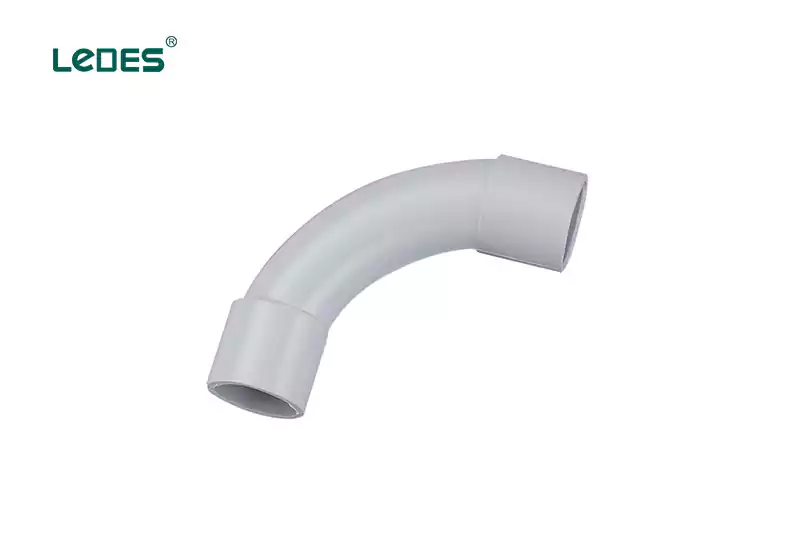
Standard Bend: A standard bend, also known as a standard elbow, is a general-purpose conduit fitting used to change the direction of a conduit system. These bends typically have a fixed angle, commonly 90 degrees, and are widely available for various conduit sizes.
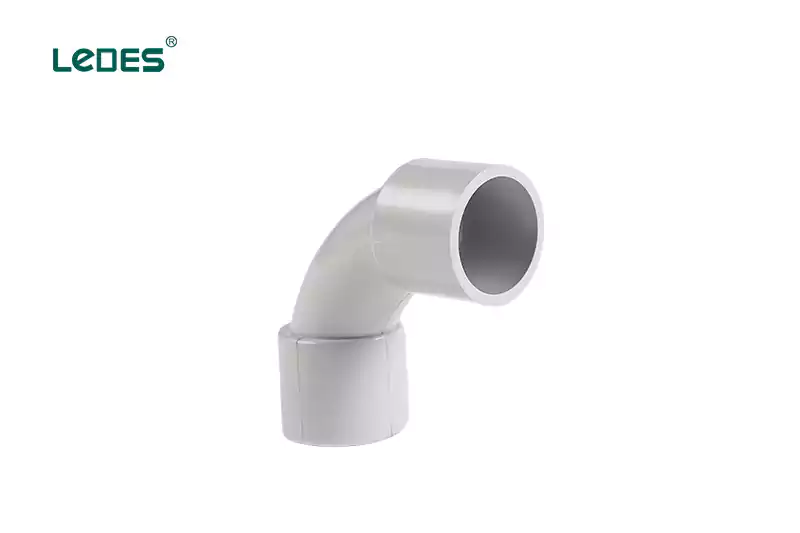
Solid Elbow: A solid elbow is a conduit fitting that provides a rigid and immovable change in direction for a conduit system. It is typically made of the same material as the conduit itself and is used when a permanent and secure angle is required.
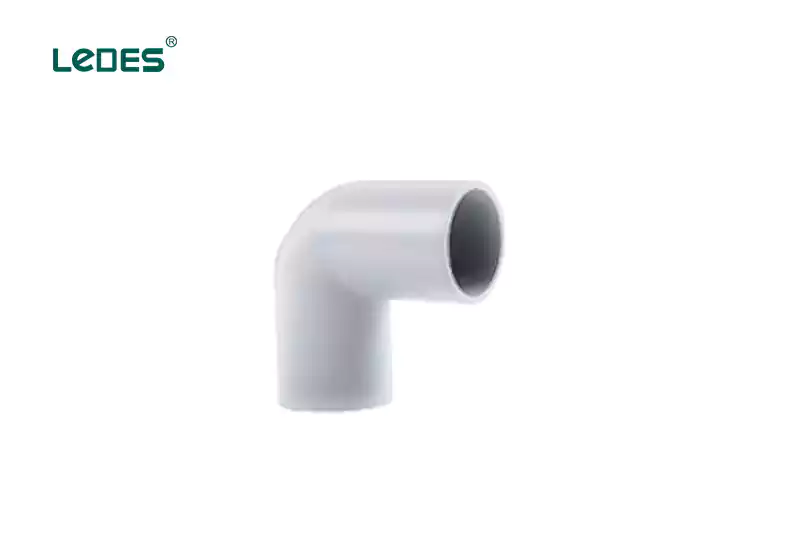
90 Degree Elbow: A bend for 90 degrees direction change, with no socket end.
Standard Electrical Bend VS Special Conduit Elbow
Standard Bend:
A standard bend, also known as a standard elbow, is a commonly used conduit fitting that provides a fixed angle of change in direction for a conduit system. These bends typically have a predetermined angle, most commonly 90 degrees, and are widely available in various sizes to accommodate different conduit diameters.
Key characteristics of standard bends include:
- Fixed Angle: Standard bends come with a fixed angle, such as 90 degrees, 45 degrees, or other common angles. They provide a sharp turn in the conduit system, allowing for changes in direction at a specific angle.
- Predefined Specifications: Standard bends are manufactured with predefined specifications, including the angle of the bend and the diameter or size of the conduit it is designed to fit. These specifications are standardized and widely available in the market.
Special Elbow:
A special elbow, also known as a custom elbow or custom bend, refers to a conduit fitting that is specifically designed and manufactured to meet unique requirements in terms of curvature and specifications. Unlike standard bends, special elbows offer the flexibility to customize the angle of the bend and the dimensions according to specific project needs.
Key characteristics of special elbows include:
- Customizable Curvature: Special elbows provide the ability to customize the curvature, allowing for precise angles and turns in the conduit system. This customization enables the fitting to match the specific requirements of the installation, accommodating unique obstacles, architectural features, or space constraints.
- Tailored Specifications: Special elbows are made-to-order fittings that can be customized based on specific project specifications. This includes the angle of the bend, the radius of the curvature, the diameter or size of the conduit, and other dimensions as required.
- Manufacturing Process: Special elbows are typically fabricated through specialized manufacturing processes that involve bending the conduit to the desired angle and curvature, ensuring a precise fit for the specific application.
In summary, the main difference between a standard bend and a special elbow lies in the ability to customize the curvature and specifications. While standard bends offer fixed angles and predefined specifications, special elbows provide the flexibility to tailor the bend’s angle, radius, and dimensions to meet unique project requirements.
Electrical Conduit Elbow Sizes
Electrical conduit elbow sizes can vary between countries, and the units of measurement used can differ as well. Here’s an explanation highlighting the differences between America and Australia, along with a general overview of commonly used sizes.
In America, electrical conduit elbows are often designated by trade sizes, which represent the approximate inside diameter (ID) of the conduit. Common trade sizes for elbows include 1/2″, 3/4″, 1″, 1-1/4″, 1-1/2″, 2″, 2-1/2″, 3″, 3-1/2″, 4″, and larger.
In Australia, electrical conduit sizes are typically measured using the metric system, specifically in millimeters (mm). The most commonly used metric sizes for elbows include 16mm, 20mm, 25mm, 32mm, 40mm, 50mm, 63mm, 80mm, 100mm, and larger.
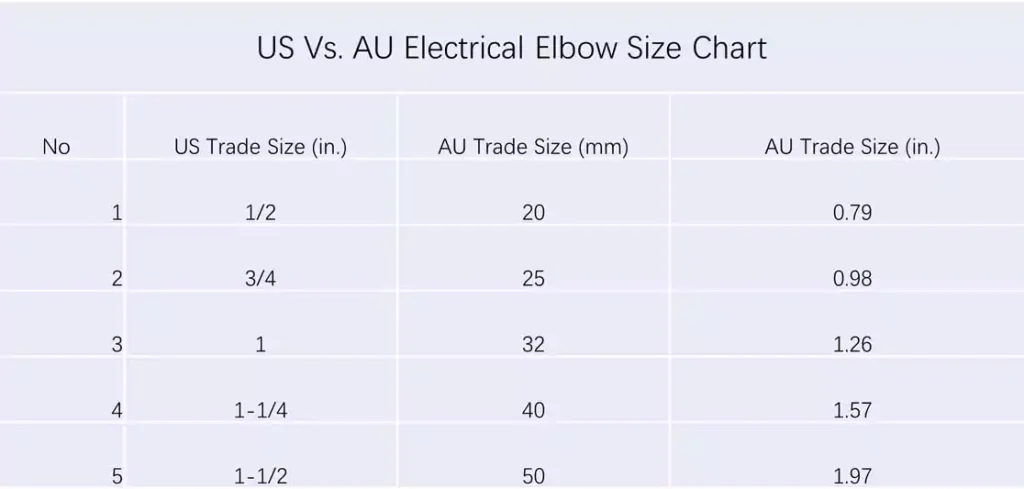
Electrical Conduit Bend Materials
Electrical conduit bends can be classified into two main material categories: plastic and metal. Within each category, there are specific materials commonly used for conduit bends.
Plastic Materials:
- PVC (Polyvinyl Chloride): PVC is a popular choice for plastic conduit bends due to its affordability, lightweight nature, and ease of installation. It is resistant to corrosion and provides good electrical insulation. PVC conduit bends are commonly used in residential and commercial applications.
- Fiberglass: Fiberglass conduit bends are made of reinforced plastic composed of glass fibers embedded in a resin matrix. They offer excellent resistance to corrosion, chemicals, and extreme temperatures. Fiberglass conduit bends are commonly used in industrial and harsh environments where durability is crucial.
Metal Materials:
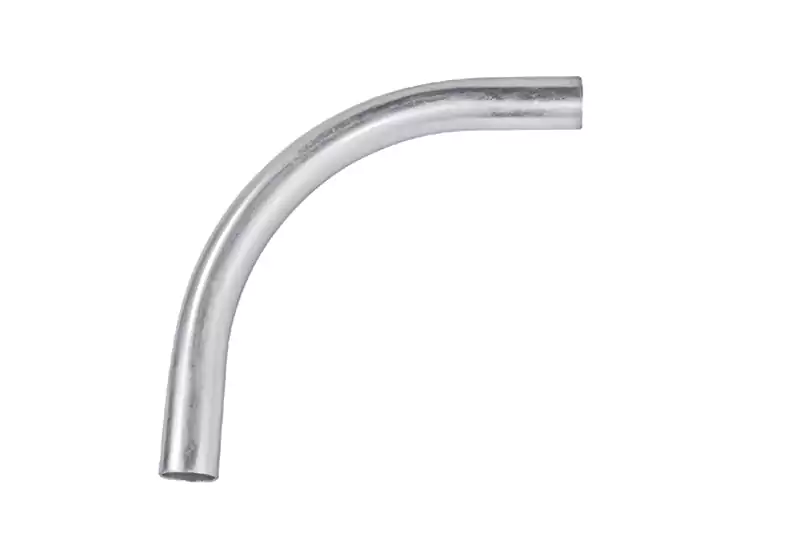
- Galvanized Steel: Galvanized steel conduit bends are made from steel coated with a layer of zinc to provide corrosion resistance. They are strong, durable, and widely used in commercial and industrial applications. Galvanized steel conduit bends are known for their high mechanical strength and are suitable for outdoor installations.
- Steel: Steel conduit bends are made of plain steel without any additional protective coating. They offer robustness and strength but are susceptible to rust. Steel conduit bends are commonly used in industrial settings where durability is essential, but corrosion resistance may not be a primary concern.
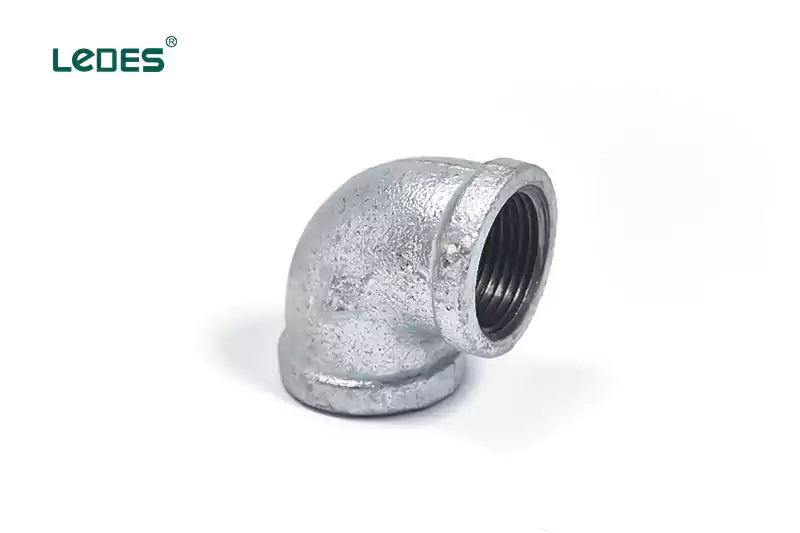
- Aluminum: Aluminum conduit bends are lightweight, corrosion-resistant, and easy to install. They are commonly used in residential and light commercial applications. Aluminum conduit bends are often chosen for their low weight and resistance to rust and corrosion.
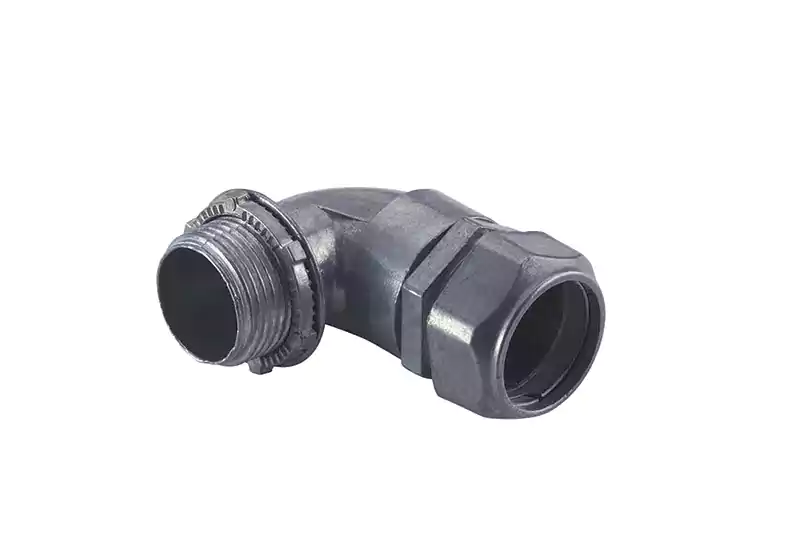
- Zinc: Zinc conduit bends are made of steel coated with a layer of zinc for corrosion protection. They provide moderate strength and corrosion resistance. Zinc conduit bends are commonly used in indoor electrical installations where durability and cost-effectiveness are important.
When selecting the material for conduit bends, it’s crucial to consider project requirements. Metal materials offer higher strength and longer theoretical lifespan but are heavier and more prone to rust. On the other hand, plastic materials do not rust, are lighter in weight, and are cost-effective. However, they may have lower strength and a comparatively shorter theoretical lifespan than metal bends.
Ultimately, the choice of conduit bend material depends on factors such as project needs, budget, environmental conditions, and the desired balance between durability, corrosion resistance, weight, and cost.
What are Electrical Conduit Elbows Used for?
Elbows are primarily used for changing the direction of electrical conduit runs. Here’s a summary of their uses:
- Direction Change: Conduit elbows are primarily used to change the direction of electrical conduit runs. They provide a smooth and gradual turn for the conduit, allowing it to navigate around obstacles, corners, or other structural elements. Elbows come in various angles, such as 90 degrees, 45 degrees, 30 degrees, and 22.5 degrees, providing flexibility in routing the conduit system.
- 电缆保护: Elbows help protect the electrical cables within the conduit by minimizing excessive bending. When wires are subjected to sharp bends, it can strain the insulation and lead to damage or premature wear. Conduit elbows offer a controlled and gradual change in direction, reducing the risk of insulation abrasion, wire breakage, or electrical faults.
- Space Optimization: In tight spaces or areas with limited room for conduit runs, elbows are crucial for optimizing space utilization. By allowing the conduit to make sharp turns or navigate corners, elbows enable efficient wire routing and help ensure that the conduit system fits within the available space. This is particularly important in applications where space constraints or architectural features pose challenges to the installation.
- Access and Pulling: Certain types of elbows serve specific purposes related to access and wire pulling. Inside corner elbows are designed for use in corners where access to the raceway is necessary. They feature removable covers or access points, allowing for easier maintenance or pulling of additional wires. Pull elbows, also known as sweep elbows, have a larger radius bend that facilitates the pulling of wires through the conduit. They minimize the risk of wire damage during installation or when adding or replacing cables.
By incorporating conduit elbows into electrical installations, professionals can achieve efficient wire routing, protect cables, adapt to challenging spaces, and ensure convenient access for maintenance or future modifications. These versatile fittings play a vital role in creating a well-designed and functional conduit system.
PVC Electrical Conduit Elbow Local Code Compliance
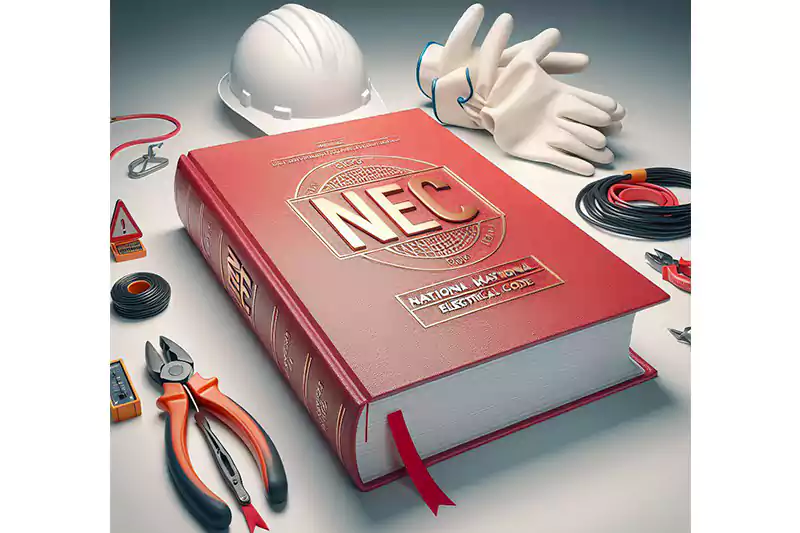
PVC conduit elbow compliance with local codes can vary between different regions, such as the United States (UL651) and Australia (AS/NZS 2053). Here are some examples of the differences based on UL651 and AS/NZS 2053:
- Types Requirement
The Australian standard, AS/NZS 2053, specifies explicit testing requirements for different types of conduit elbows, ranging from light-duty to extra-heavy-duty. It also includes specific numerical requirements for impact resistance. In addition, AS/NZS 2053 mandates marking on the conduit elbow, where the corresponding duty type, such as Light Duty (LD) or Heavy Duty (HD), is printed on the conduit surface. This allows for easy identification of the conduit’s strength rating. In contrast, UL651 does not have specific requirements for marking the conduit elbows.
- Flame Testing Definitions
The definition and testing procedures for flame resistance also differ between UL651 and AS2053/NZS 2053:
UL651 (8th Edition):
UL651 states that a fitting (including conduit elbows) shall not continue to flame for more than 5 seconds after the third application of the test flame. It also specifies that no flaming particles or drops should fall from the fitting during or after any application of the test flame.
AS/NZS 2053.1 (PVC Rigid Conduit and Fittings):
AS/NZS 2053 describes the flame testing procedure in detail. It requires the burner to be supported at an angle of 45 ±2° to the vertical. The flame is applied to the samples of conduit so that the distance from the top of the burner tube to the same, measured along the axis of the flame, shall be 100±10 mm, and the axis of the flame shall intersect with the surface of the sample at a point 100±5 mm from the upper extremity of the lower clamp, and so that the axis of the flame intersects with the axis of the sample.
The flame is applied for a period of 60 ±1 s, and the sample should not be moved during the test. AS2053 also specifies that the flame test should be conducted on three samples.
Please note that the information provided is sourced from Standards Australia and UL (Underwriters Laboratories Inc.), and these organizations hold the final authority on interpreting the mentioned standards.
In conclusion, the variations in testing standards between different regions can result in differences in performance indicators for conduit elbows. However, as long as the products comply with the local code requirements, their quality and suitability for use are ensured.
Electrical Conduit Elbow vs. Coupler: What's the Difference?
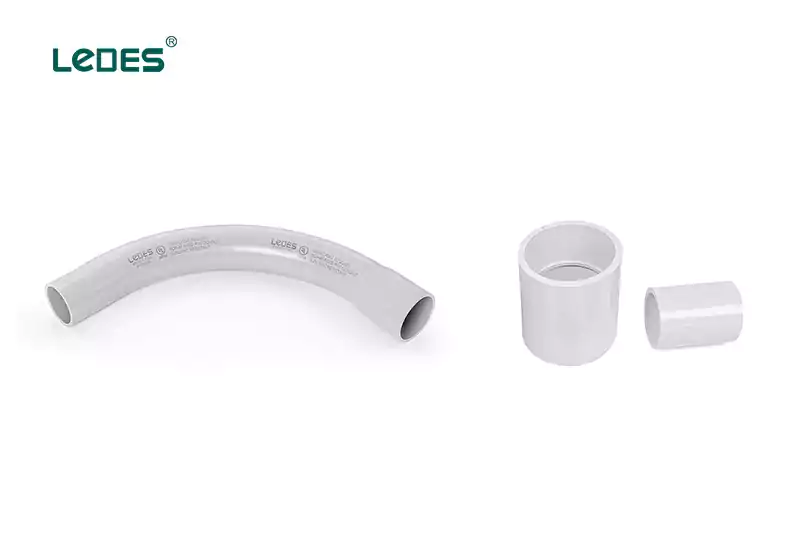
Appearance:
Firstly, the two can be easily distinguished based on their appearance. A conduit elbow typically has a curved or bent shape, resembling a bent section of conduit. On the other hand, a coupler has a straight design, resembling a straight section of conduit.
目的:
The key distinction between conduit elbows and couplers lies in their design and purpose. Conduit elbows are primarily used to change the direction of a conduit run. They come in preformed bends of 45 degrees and 90 degrees, suitable for both metallic and nonmetallic conduits. Inside corner and pull elbows are particularly useful in tight spaces or when access to the raceway is necessary.
On the other hand, couplers are commonly employed to join a conduit run to a surface-mounted socket or switch back box. They provide a means of connecting separate sections of conduit, facilitating the continuation of the conduit run or connecting it to an outlet or junction box.
Due to their distinct designs and intended applications, it is important to avoid confusion between conduit elbows and couplers during procurement and construction processes.
How to Install Electrical Conduit Elbows?
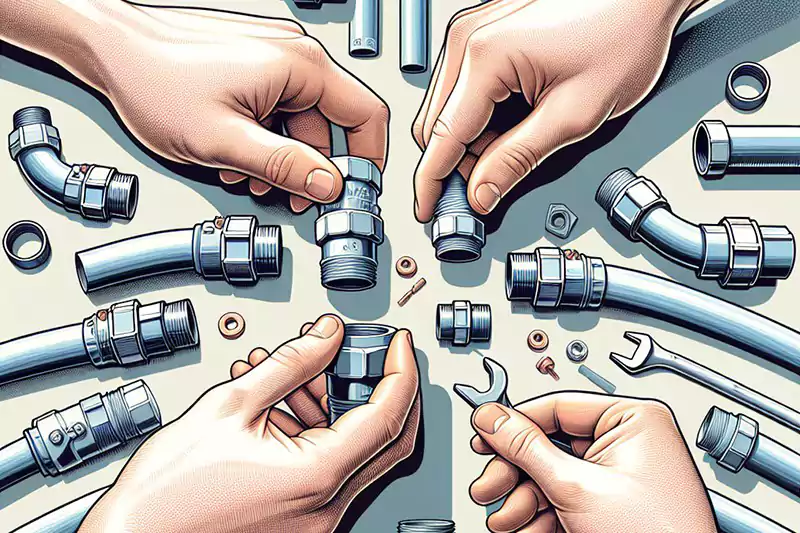
Installing Metal Conduit Elbows:
- Gather the necessary materials and tools:
Metal conduit elbows
Metal conduit pipes
Conduit connectors or couplings
Hacksaw or pipe cutter
Deburring tool or utility knife
Screwdriver or wrench (if required for connectors)
- Measure and cut the metal conduit pipes:
Determine the desired length of the conduit pipes leading to the elbow.
Use a hacksaw or pipe cutter to cut the metal conduit pipes to the appropriate length. Ensure that the cuts are straight and clean.
- Prepare the metal conduit elbows:
Loosen any set screws or locknuts on the elbows to open them.
- Connect the metal conduit pipes to the elbows:
Insert one end of the metal conduit pipe into the open end of the elbow.
If the metal elbow has set screws or locknuts, tighten them securely to hold the conduit pipe in place.
If using a coupling or connector, follow the manufacturer’s instructions to connect the conduit pipe to the elbow.
- Connect the remaining metal conduit pipes:
Repeat the process outlined in step 4 to connect additional metal conduit pipes to the other end of the elbow.
Use couplings or connectors to securely join the metal conduit pipes together. Tighten them properly using a screwdriver or wrench.
- Secure the metal conduit assembly:
Ensure that the metal conduit assembly is properly aligned and supported.
Use straps or conduit clamps to secure the conduit to a wall or other suitable surface.
Installing Plastic Electrical Conduit Elbows:
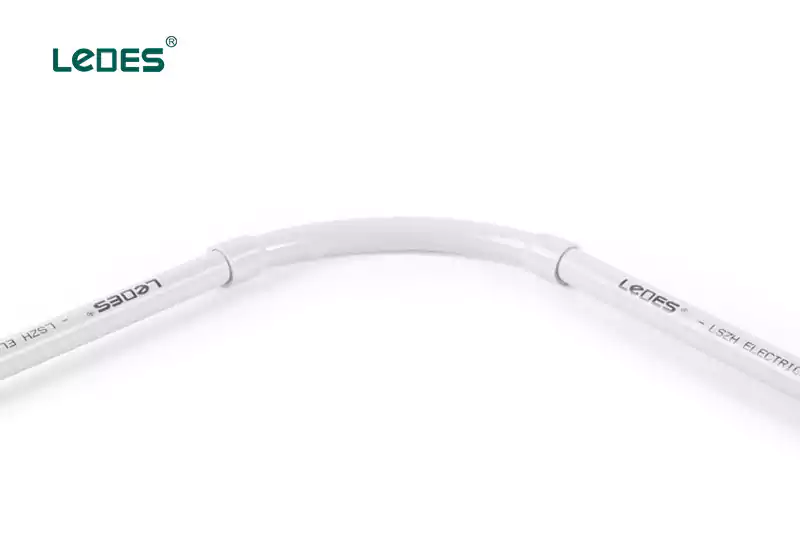
- Gather the necessary materials and tools:
Plastic conduit elbows
Plastic conduit pipes
Conduit connectors or couplings
Hacksaw or pipe cutter
Deburring tool or utility knife
Conduit cement
- Measure and cut the plastic conduit pipes:
Determine the desired length of the conduit pipes leading to the elbow.
Use a hacksaw or pipe cutter to cut the plastic conduit pipes to the appropriate length. Ensure that the cuts are straight and clean.
- Prepare the plastic conduit elbows:
Clean the ends of the conduit and the inside of the elbow with a deburring tool or utility knife to remove any burrs or rough edges.
- Connect the plastic conduit pipes to the elbows:
Apply conduit cement to the inside of the elbow and the outside of the plastic conduit pipe.
Insert the conduit pipe into the elbow and hold it firmly for a few seconds to allow the cement to set.
- Connect the remaining plastic conduit pipes:
Repeat the process outlined in step 4 to connect additional plastic conduit pipes to the other end of the elbow.
Use couplings or connectors to securely join the plastic conduit pipes together. Follow the manufacturer’s instructions for installation.
- Secure the plastic conduit assembly:
Ensure that the plastic conduit assembly is properly aligned and supported.
Use straps or conduit clamps to secure the conduit to a wall or other suitable surface.
Remember to follow any specific instructions provided by the manufacturer of the conduit elbows and connectors you are using. Additionally, adhere to local electrical codes and regulations when installing conduit for electrical wiring purposes. If you are uncertain about any aspect of the installation, it is advisable to consult a qualified electrician or professional.
How to Make Electrical Conduit Elbows?
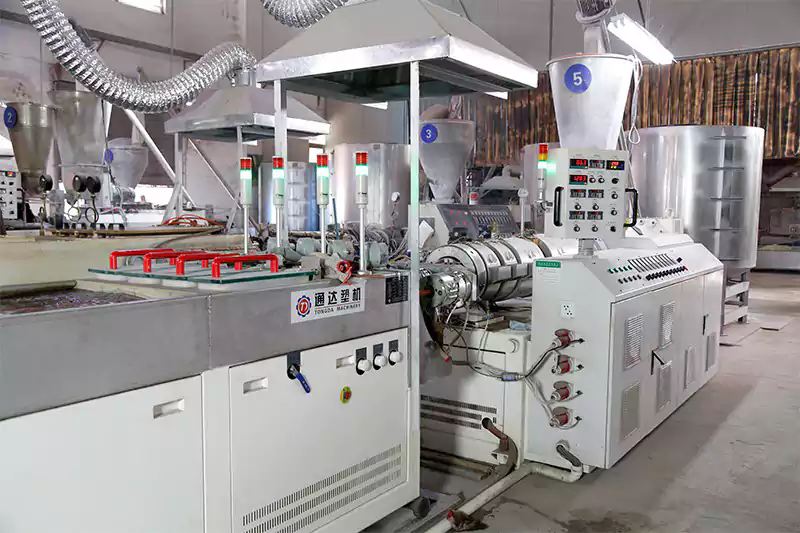
Here is a general outline of the manufacturing process for plastic PVC elbows:
- PVC resin preparation: The first step is to prepare the PVC resin by blending it with additives and stabilizers to achieve the desired properties such as strength, flexibility, and resistance to UV rays and chemicals.
- Extrusion of PVC pipes: The PVC resin is fed into an extruder machine, where it is heated and melted to form a molten PVC compound. The molten PVC is then pushed through a die, which gives it the shape of a continuous pipe. The extruded pipe is cooled and solidified as it passes through a water bath or cooling chamber.
- Mold preparation: Mold cavities are prepared for the elbow shape. These molds are typically made of metal and consist of two halves that fit together. The mold cavities are precisely machined to create the desired elbow shape and dimensions.
- Injection molding: In this step, the cooled and solidified PVC pipes from the extrusion process are cut into specific lengths and fed into an injection molding machine. The injection molding machine consists of a heated barrel and a screw mechanism. The PVC pipe pieces are introduced into the barrel, where they are melted and transported by the screw to the mold cavity.
- Molding the elbow shape: The molten PVC is injected into the mold cavity at high pressure. The mold is designed to create the elbow shape, including the desired angle and radius. The PVC material fills the mold cavities and takes the shape of the elbow.
- Cooling and solidification: After the PVC material is injected into the mold, it is allowed to cool and solidify. Cooling can be accelerated through the use of cooling channels or water sprays. This step ensures that the PVC material retains its shape and stability.
- Mold opening and ejection: Once the PVC material has solidified, the mold is opened, and the newly formed PVC elbow is ejected from the mold cavity. The ejection can be facilitated through the use of ejector pins or air blasts.
- Trimming and finishing: The ejected PVC elbows may have excess material or flash that needs to be removed. Trimming is carried out to remove any unwanted portions and achieve a smooth, finished surface. This can be done manually or using automated trimming equipment.
- Quality control and inspection: The PVC elbows undergo quality control checks to ensure they meet the required specifications and standards. This may include dimensional checks, visual inspections, and tests for strength and durability.
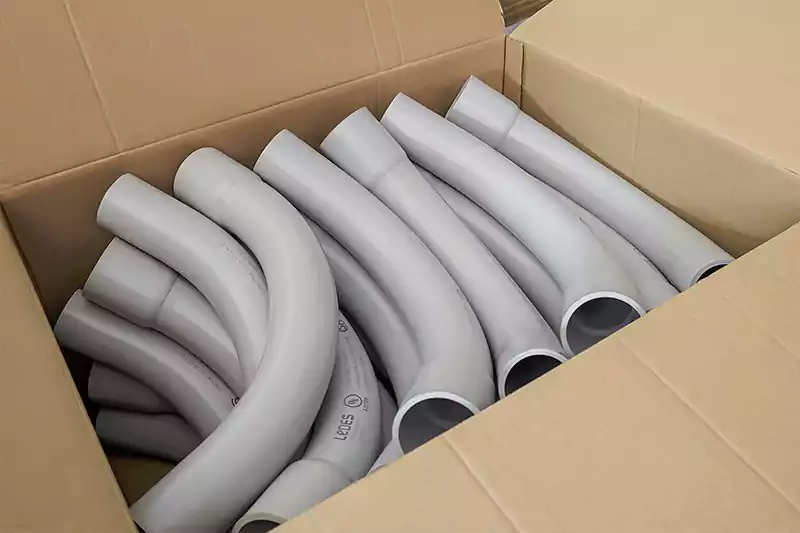
- Packaging and distribution: After passing the quality control checks, the PVC elbows are packaged and prepared for distribution. They may be bundled, boxed, or placed on pallets, depending on the manufacturer’s packaging standards. The packaged PVC elbows are then shipped to distributors or customers.
5 things you need to know before purchased electrical elbow
Requirements
Assess the basic needs of the product based on your project or usage environment. For example, determine whether you need the elbows for embedding in standard residential buildings, long-term outdoor use, or if they will be exposed to humid conditions. By considering the advantages and disadvantages of various elbow products, we can help you make the right choice. If you are a project contractor or distributor, please contact us for further purchasing advice.
Budget

Select products that fit your project within your budget. This ensures that you meet project requirements while minimizing procurement costs and obtaining good-quality products. In addition to the cost of purchasing the products, consider transportation and installation costs. For instance, as mentioned earlier, metal elbows are heavier, resulting in increased transportation and installation expenses. Therefore, it’s important to factor in these costs when allocating your total budget.
尺寸和数量:
Based on installation and construction requirements, determine the quantity and quality standards needed. This allows you to purchase the desired quantity of elbows within your budget while meeting quality requirements.
品牌:
Different types of elbows are available from various brands. Purchasing products from reputable brands may come at a slightly higher price, but the quality is significantly better. Well-known brands have undergone local certifications. Buying unknown brands may result in potential quality issues, and the resulting losses could far exceed the product’s value. If local brand prices are too high or you require bulk purchases, you can consider purchasing directly from manufacturers, such as Ledes. As a manufacturer, Ledes operates as a factory without intermediaries, offering relatively lower prices. Moreover, with over 14 years of export experience and serving thousands of customers, Ledes ensures timely delivery of goods once you place your order.
If you would like to inquire about our products, 请点击此处向我们发送电子邮件。
结论
In conclusion, conduit elbows play a crucial role in electrical installations, providing flexibility and efficient routing of wires and cables. This article has provided a comprehensive overview of conduit elbows, covering their types, materials, sizes, and installation considerations.
Remember, selecting the right conduit elbows is essential for a safe and efficient electrical installation. By choosing our high-quality products, you can ensure reliable performance and peace of mind for your projects.
If you are interested in conduit elbows, as a manufacturer, we offer PVC elbow wholesaler prices. You can submit a contact form 或者 email us to request a product catalog and quotation free of charge. We are dedicated to providing high-quality conduit elbows and excellent customer service. Don’t hesitate to reach out to us for more information or to place an order. We look forward to serving you!



